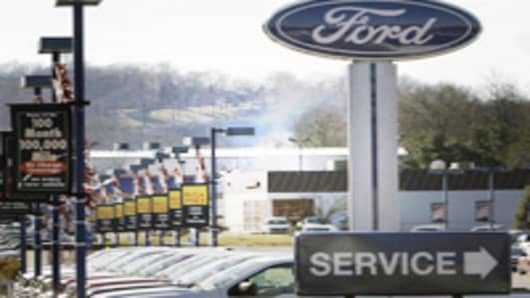G.M. and Chrysler declined to disclose the travel plans of their leaders this time.
But the Big Three also need substantive changes to drastically cut costs, industry analysts said, including trimming their glut of products and sprawling distribution networks to go with their shrinking market shares.
“Downsizing brands and models is the minimum they have to do,” said John Casesa, a principal in the auto consulting firm the Casesa Shapiro Group. “This can’t just be about resizing the companies, but also restructuring them.”
Ford took a step on Monday toward reducing its brand lineup by announcing it was considering the sale of Volvo, its Swedish luxury brand. Volvo sales have fallen 28 percent so far this year.
“Given the unprecedented external challenges facing Ford and the entire industry, it is prudent for Ford to evaluate options for Volvo,” Mr. Mulally said.
G.M. is already trying to sell its Hummer brand. In its report to Congress on Tuesday, the company may settle widespread speculation that it is considering selling or eliminating the Saab, Saturn and Pontiac brands as well.
People familiar with G.M.’s deliberations said that the company had considered earlier this fall a plan to put the Saab and Saturn brands up for sale. But those plans were dropped because of the lack of potential buyers. With a market share so far this year of about 22 percent in the United States, G.M. is struggling with the costs of filling showrooms with eight separate brand lineups.
“Cutting Saab and Hummer are no-brainers because each of them has 0.2 percent of market share, so they’re irrelevant,” said Jerome P. York, who was a member of G.M.’s board during 2006. “Beyond that, Pontiac looks very suspect to me.”
But shutting down a brand is a complicated and costly effort that requires buying out dealers protected by state franchise laws, as well as scaling back production of vehicles. In 2000, G.M. decided to eliminate its Oldsmobile brand after its sales fell from 1.1 million vehicles a year in 1985 to about 265,000 a year. But the process took nearly four years and cost G.M. more than $1 billion. Rick Wagoner, the automaker’s chairman, has repeatedly cited the problems of closing Oldsmobile as a prime reason to avoid eliminating more brands.
G.M., however, is spending down its cash hoard by $2 billion a month, and the company has acknowledged that it is teetering dangerously close to bankruptcy. In asking for up to $12 billion in federal loans, Mr. Wagoner told lawmakers last month that the company could run out of cash by the end of the year without government assistance.
Shrinking dealer networks may be another important component of the business plans that G.M., Ford and Chrysler will present Tuesday in an effort to convince Congress that they have viable, long-term strategies.
G.M., for example, has about 6,700 dealers in the United States, compared to 1,200 for Toyota (the disparity is even greater when franchises are counted — G.M. dealers operate 14,000 franchises for its many brands, compared to 1,600 franchises for Toyota).
Separately, union leaders will meet on Wednesday in an emergency session in Detroit to possibly discuss renegotiating terms of the latest contract, Bloomberg News reported.
The automakers are also bracing for news on Tuesday of yet another dismal month in the marketplace. Sales of new vehicles are expected to fall 27 percent for November from the same period last year, according to the auto research Web site Edmunds.com.
The forecasts by Edmunds.com suggest that Chrysler’s sales were down 41 percent in November, Ford’s 33 percent, and G.M.’s 28 percent.
Analysts said that dealers were still being hurt by a lack of available credit for consumers shopping for new vehicles.
“Until credit actually loosens up, we’re going to see a suppressed situation that is not sustainable in the long term,” said Tom Libby, senior director of industry analysis for J. D. Power & Associates.


